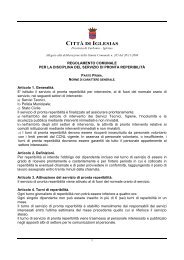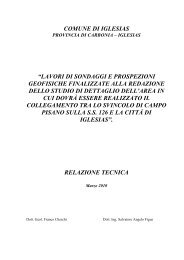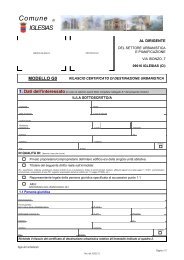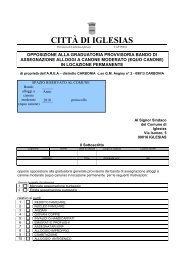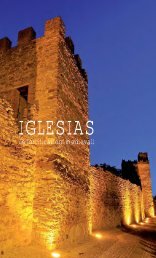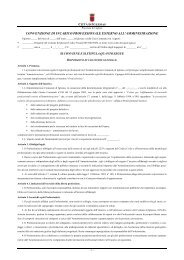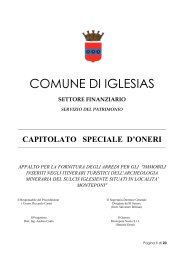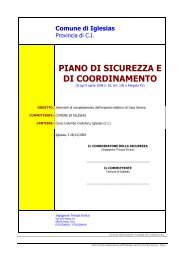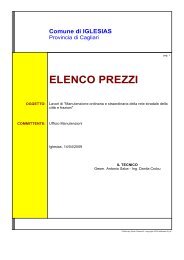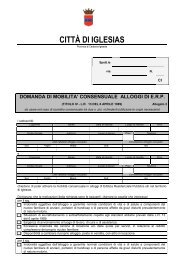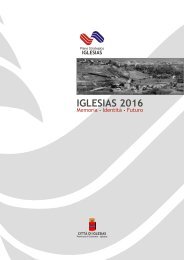Architetture religiose e arte sacra - Comune di Iglesias
Architetture religiose e arte sacra - Comune di Iglesias
Architetture religiose e arte sacra - Comune di Iglesias
You also want an ePaper? Increase the reach of your titles
YUMPU automatically turns print PDFs into web optimized ePapers that Google loves.
Pila per l’acqua santa - Holy-water font<br />
Interno - Interior<br />
Several gravestones were inserted along the nave<br />
walls. Four side chapels open along the walls. They<br />
are all barrel vaulted, except for the one de<strong>di</strong>cated to<br />
the Virgin of the Assumption, which has got a<br />
pavilion dome.<br />
Built in 1641 by the Confraternity of the Rosary, this<br />
chapel was used by the sodality for their meetings.<br />
Then, in 1699, a house adjacent to the right side of<br />
the e<strong>di</strong>fice was ceded to the brothers to use it as their<br />
Oratory.<br />
The first chapel on the left presents a marble altar<br />
with a statue of San Domenico. Three niches host the<br />
simulacra of the Virgin of the Defence, of San Biagio<br />
and Sant'Anna.<br />
The chapels on the right were built 1910-1926. The<br />
th<br />
first one hosts a Crucifix; in a side niche is a 17 -C.<br />
wooden polychrome statue of St. V. Ferrer. The other<br />
chapel, featured as a grotto, is de<strong>di</strong>cated to the Virgin<br />
of Lourdes.<br />
l prospetto del san Domenico, a<br />
terminale piano con merlatura a<br />
Ie<strong>di</strong>fici<br />
denti <strong>di</strong> sega, rimanda, invece, a<br />
coevi del meri<strong>di</strong>one<br />
dell'isola; e<strong>di</strong>fici a loro volta<br />
impostati su modelli provenienti<br />
dal meri<strong>di</strong>one della penisola Iberica<br />
e più precisamente dalla chiesa <strong>di</strong><br />
San Giorgio <strong>di</strong> Plobet (Catalogna).<br />
L’interno ha pianta ad aula<br />
mononavata, <strong>di</strong>visa in quattro<br />
campate da archi a sesto acuto<br />
impostati su semi pilastri realizzati<br />
in conci <strong>di</strong> trachite. A destra<br />
dell'ingresso è posta la pila per<br />
l'acqua santa. Si tratta <strong>di</strong> un<br />
manufatto realizzato nel 1611 in<br />
marmo bianco e recante lo stemma<br />
del vescovo Canavera.<br />
Sulle pareti della navata vennero<br />
collocate <strong>di</strong>verse lastre tombali che<br />
in origine risultavano inserite nella<br />
pavimentazione. La prima a destra<br />
è del canonico Francesco Fontana,<br />
morto nel 1801, la seconda reca il<br />
settecentesco epitaffio del canonico<br />
Benedetto Apostoli il cui ritratto è<br />
scolpito in alto rilievo sul marmo.<br />
La terza lastra tombale è del<br />
vescovo Nicolò Canavera (morto il<br />
13 luglio 1613). L'ultima epigrafe si<br />
trova nella parete sinistra; è <strong>di</strong><br />
Giovanni Battista Cogoti e risale al<br />
1772.<br />
Lastra tombale del vescovo Canavera<br />
Bishop Canavera's gravestone<br />
31



